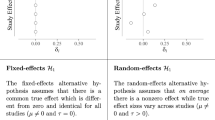Abstract
The goal of meta-analysis is to integrate the research results of a number of studies on a specific topic. Characteristic for meta-analysis is that in general only the summary statistics of the studies are used and not the original data. When the published research results to be integrated are longitudinal, multilevel analysis can be used for the meta-analysis. We will demonstrate this with an example of longitudinal data on the mental development of infants. We distinguish four levels in the data. The highest level (4) is the publication, in which the results of one or more studies are published. The third level consists of the separate studies. At this level we have knowledge about the degree of prematurity of the group of infants in the specific study. The second level are the repeated measures. We have data about the test age, the mental development, the corresponding standard deviations, and the sample sizes. The lowest level is needed for the specification of the meta-analysis model. Both the way in which the multilevel model has to be specified (the Mln-program is used) as the results will be presented and interpreted.
Similar content being viewed by others
References
Bryk, A. S. & Raudenbush, S. W. (1992). Hierarchical linear models. Newbury Park, CA: Sage.
Bryk, A. S., Raudenbush, S. W. & Congdon, R. T. (1994). HLM 2/3. Hierarchical linear modeling with the HLM/2L and HLM/3L programs. Chicago: Scientific Software International.
Cornell, J. & Mulrow, C. (1999). Meta-analysis. In: H. J. Ader and G. J. Mellenbergh (eds.), Research methodology in the social, behavioral, and life sciences. London: Sage.
Glass, G. V. (1976). Primary, secondary and meta analysis of research. Educational Researcher 10: 3–8.
Goldstein, H. (1995). Multilevel statistical models. London: Edward Arnold.
Hedges, L. V. & Olkin, I. (1985). Statistical methods for meta-analysis. San Diego, CA: Academic Press.
Hunter, J. E. & Schmidt, F. L. (1990). Methods of meta-analysis. Newbury Park, CA: Sage.
Light, R. J. & Pillemer, D. B. (1984). Summing up: The science of reviewing research. Cambridge, MA: Harvard University Press.
Lipsey, M. W. & Wilson, D. B. (2001). Practical meta-analysis. Thousand Oaks, CA: Sage.
Rasbash, J. & Woodhouse, G. (1995). MLn command guide. London: Multilevel Models Project, University of London.
Raudenbush, S. W. (1994). Random effects models. In: H. Cooper & L. V. Hedges (eds.), The handbook of research synthesis. New York: Russell Sage Foundation.
Raudenbush, S. W. & Bryk, A. S. (1985). Empirical Bayes meta analysis. Journal of Educational Statistics 10: 75–98.
Schwarzer, R. (1989). Meta-analysis programs. Program manual. Berlijn: Institüt für Psychologie, Freie Universität Berlin.
Rights and permissions
About this article
Cite this article
Maas, C.J.M., Hox, J.J. & Lensvelt-Mulders, G.J.L.M. Longitudinal Meta-analysis. Quality & Quantity 38, 381–389 (2004). https://doi.org/10.1023/B:QUQU.0000043125.43736.c4
Issue Date:
DOI: https://doi.org/10.1023/B:QUQU.0000043125.43736.c4




